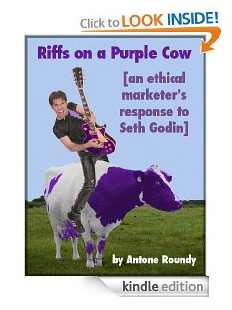Using Sunk Costs as Marketing Motivators
by Antone Roundy | Add Your Comments | Marketing, Premium Content
A while back, I needed a FireWire port to hook a camera up to my computer. I knew I had one in a box somewhere, so I spent...oh, I don't know how much time searching through boxes.
I didn't find it in any of the boxes I thought it was in, so I checked a few other places, and then re-checked some places I'd already looked again.
I never found it.
In the end, I ordered a new one off Amazon.com for about 10 bucks.
The really stupid thing is that the time I spent looking for the lost card was worth more than $10. And it didn't take me long to realize that it would be. But instead of ending my search, buying a new card, and getting back to doing something more valuable, I kept looking.
Why?
Because people hate losing things. We hate spending money on the same thing twice, even if it "costs" us more to find a lost item than to buy a new one.
Over at You Are Not So Smart, David McRaney posted an article about The Sunk Cost Fallacy:
Have you ever gone to see a movie only to realize within 15 minutes or so you are watching one of the worst films ever made, but you sat through it anyway? You didn't want to waste the money, so you slid back in your chair and suffered.
...Sunk costs are a favorite subject of economists. Simply put, they are payments, investments or costs which can never be recovered. An android with fully functioning logic circuits would never make a decision which took sunk costs into account, but you would.
In my case, I had two sunk costs that I didn't want to abandon: the cost of the old card, and the cost of the time I'd already spent looking for it. But how much should those things have factored into my decision?
My options were A) spend $10 or B) spend more time looking. If my confidence were high that the time I'd already spent looking had eliminated enough places where the card might have been that I'd be able to find it with less than $10 worth of additional looking time, option B would have been a smart choice. But not because of the value of the time I'd already spent. And not because of the cost of the old card.
Consider David's bad movie example: you're sitting in a bad movie. Your options are A) suffer through more of the movie, or B) leave and do something enjoyable. If you only consider the future, which is the better option? B, of course.
If you stay and watch the rest of the movie, then instead of just wasting the price of the ticket and 15 minutes, you'll be wasting the price of the ticket and 2 hours. The price of the ticket is gone, no matter which option you choose. And yet, we tend to choose option A.
So how can we use sunk costs in marketing (without abusing our customers?)
What is a Hammer? A Tool or a Weapon?
Like most marketing techniques, sunk costs can be used both ethically and unethically to motivate customers.
David's article talks about Farmville. Players start off by spending a little time planting some crops. The crops grow. And then the player has two options: A) spend more time taking care of your crops, or B) let them die and do something more useful and enjoyable with your life. Sadly, people choose option A to the tune of 70 million man hours per week.
I'm sure there are people who really enjoy playing Farmville. But even among them, how many do you think would spend as much time in the game if they didn't have to check in regularly to save their virtual crops from withering? They're losing to the fear of loss in two ways: they've got the sunk cost of the time they've put into growing their virtual crops, and the crops themselves.
Farmville uses sunk costs as a hammer. So do many internet marketers.
"Upsell Hell"
In her "Internet Marketing Sins", Sylvie Fortin talks about "Upsell Hell" -- the seemly endless string of upsells that some marketers offer once you've purchased their product...and before you can download it.
The worst offenders are those whose sales letters promise easy "Easy Button" riches, but once you've bought, the upsells tell you how you need to buy something else to make it work. "Thanks for buying the Insta-Cashinator 3000. For another $47, I'll sell you the batteries...Sucka!" You've already paid $97 for the Insta-Cashinator 3000, and now you've got two options: A) ask for a refund, or B) cough up $47 for the batteries you didn't know you needed.
Hammer.
Tool
Don't get me wrong. There's nothing wrong with offering additional products that help people get more out of what they've already bought. Just don't require extra purchases before the product will do what you already promised or implied.
So, how do you use sunk costs or aversion to loss to motivate customers? Here are a few keys:
- Make the easy sale first -- the less expensive product, or the better deal (even pricing it for a lower or zero profit margin) -- and then offer upgrades. The time and/or money they've put into the initial product becomes the sunk cost. They don't risk losing it if they don't upgrade, but it will figure into the equation.
- Let the customer use the base product for a while and see its value first, and then upsell the add-ons in your autoresponder sequence. Or make the upsell offer immediately, and repeat it later after they've had some good experiences with your product and company.
- They can't be averse to the loss of something they don't already have -- you've got to get them to feel like they've already got something to lose.
- When they arrive at your offer page, they have the opportunity to get the product. Limited time offers can be used to threaten loss of opportunity. Just don't use this as a hammer strategy. For example, if they can reset the time limit simply by reloading the page or deleting a browser cookie, you're using it as a hammer, and clumsily at that. Many people consider all limited offers that aren't tied to an unavoidable reason (like limited available quantities of a physical product) to be unethical, so be aware that you will alienate some potential customers if you use them.
- Give away something valuable for free that introduces a paid product. For example, I give away a free eBook that teaches the philosophy and method behind Blog Riffing (download links are at the top of the page). The free information itself is useful by itself, but even more valuable if you buy SEO Content Factory, a tool that makes the method quicker and easier to implement.
- If you can make your free product expire after a certain amount of time, that can be very effective, particularly if your product becomes part of their business. For example, I offer two free weeks of my RSS to HTML conversion service. At the end of two weeks, the feeds are automatically replaced with an error message. Since the content is part of the user's website, they have 3 options: A) leave the error message there, B) remove the code from their webpage, or C) pay for the service. Only option A is passive -- and it's not very desirable. If they like having the content on their page, odds are good they'll choose option C.
- If you can make only part of the product expire, that may be even more effective. Even if they don't pay to get the full benefits back immediately, they'll be constantly reminded of what they've lost.
- Encourage people to use the part of the product that's going to expire before it expires. For example, if you're giving away 2 weeks of Gold Membership on membership site, use your early autoresponder messages to entice them to use the Gold Level features first. But be sure that the features they're left with after they're downgraded to free membership are good enough to keep them coming back so that you can keep reminding them of what they've lost.




